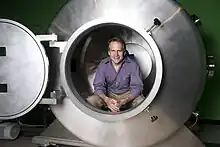Taber MacCallum
Taber MacCallum is the co-founder and co-CEO of Space Perspective,[1] a human spaceflight company planning to take people and payloads to the edge of space by balloon, and the former Chairman of the Commercial Spaceflight Federation (CSF). He is co-founder and former CTO of World View Enterprises, a stratospheric balloon company using its un-crewed Stratollite for remote communications and sensing. MacCallum was also a founding member of the Biosphere 2 design team and a crew member from the original two-year mission inside the materially-closed ecological system.

Prior to World View, MacCallum served as co-founder, CEO and CTO of Paragon Space Development Corporation, a designer and manufacturer of hazardous environment life support equipment. During his tenure at Paragon, MacCallum served as the CTO and safety officer for Alan Eustace's world record altitude skydive, a project that launched Eustace to 135,899 ft (25.74 mi; 41.42 km) under a helium balloon in 2014.[2] He also served as Chief Technology Officer for Inspiration Mars Foundation, which detailed plans for an almost two-year fly-by mission around Mars with two crew members, and published performance data from a complete life support system hardware demonstration, demonstrating recycling of wastewater and oxygen.
Space Perspective
Space Perspective is a high-altitude flight tourism company, founded and incorporated in 2019 by Taber MacCallum and Jane Poynter with plans to launch its nine-person "Spaceship Neptune" crewed balloon from NASA Kennedy Space Center.
On June 18, 2020, Space Perspective announced its plans to balloon passengers to nearly 100,000 feet above the Earth for roughly USD$125,000 per ticket.[3][4]
On December 2, 2020, Space Perspective closed its seed funding round; US$7 million of funding was gathered. The company planned an uncrewed test flight in the first half of 2021 and crewed operational flights by the end of 2024.[5]
World View
World View Enterprises, doing business as World View, is a private American near-space exploration and technology company headquartered in Tucson, Arizona, founded with the goal of increasing access to and the utilization of the stratosphere for scientific, commercial, and economic purposes.
The Stratollite
The Stratollite[6] is a remotely operated, navigable, uncrewed stratospheric flight vehicle designed and engineered to station-keep over customer-specified areas of interest for long periods of time (days, weeks, and months). The Stratollite uses proprietary altitude control technology to rise and lower in the stratosphere, harnessing the natural currents of varying stratospheric winds to provide point-to-point navigation and loitering. The Stratollite operates at altitudes up to 95,000 feet (29 km) with a payload capacity of 50 kilograms (110 lb) and 250W of continuous power to payloads. The Stratollite is primarily used for applications including remote sensing, communications, and weather.[7]
Paragon Space Development Corporation
Taber is a co-founder and served as CEO for over 20 years. He was the Principal Investigator on four microgravity experiments on the Space Shuttle, Mir Space Station and International Space Station using Paragon's patented[8] Autonomous Biological System, a long duration plant and aquatic animal life support system[8] and has supported numerous other biological experiments on the Space Shuttle and International Space Station. He conceived and was involved in the design of a Mars space suit portable life support system technology[9] funded by NASA, life support and thermal control systems for commercial crewed orbital and suborbital spacecraft, as well as hazardous environment life support technology for U.S. Navy divers. In 2008, Popular Science named MacCallum Inventor of the Year.[10]
Biosphere 2
Prior to Paragon, MacCallum was a founding member of the Biosphere 2 Design, Development, Test and Operations team, and a crew member in the first two-year mission.
MacCallum's training for Biosphere 2 led him to work on a research vessel, eventually holding every level of command, sailing to over 40 ports and over 30,000 miles around the world.[11] Training in Singapore, he became certified as a dive controller and Advanced Open Water Diving Instructor. He served as dive master for a project to reintroduce two captive dolphins to the wild.[11]
References
- "New Tourism Company Space Perspective Aims To Make Space Accessible To As Many People As Possible". Forbes.
- Betancourt, Mark (January 2017). "The Highest Jump". Air and Space Magazine.
- Mosher, Dave (2020). "A new spaceship-on-a-balloon startup wants to float you high enough to see Earth's curvature and the darkness of space for roughly $125,000 per ticket". BusinessInsider. Retrieved 2020-07-09.
- "World View founders launch new stratospheric ballooning venture". 18 June 2020.
- "Stratospheric ballooning company Space Perspective raises $7 million". 2 December 2020.
- Etherington, Darrell (February 23, 2017). "World View's 'stratollites' and new spaceport aim to change the business of space". techcrunch.com. Retrieved 23 February 2017.
- Button, Keith (October 2017). "Satellite envy". Aerospace America.
- United States Patent 5,865,141 Autonomous Biological System (ABS)
- United States Patent 2009/0172935 A1 Paragon Dive System
- "Paragon Dive System".
- Biosphere 2 Training, archived from the original on 2014-11-11